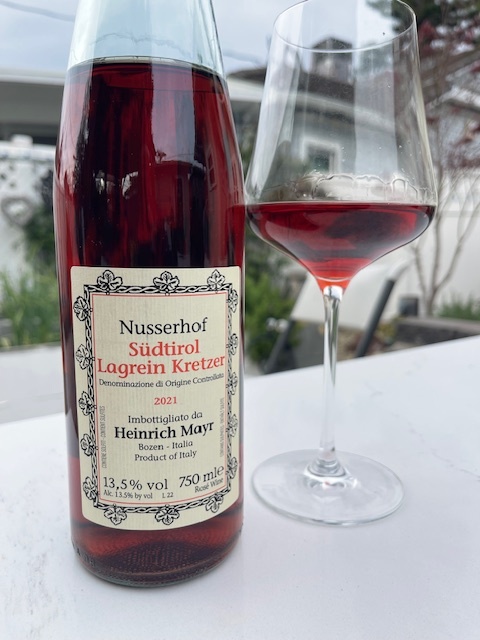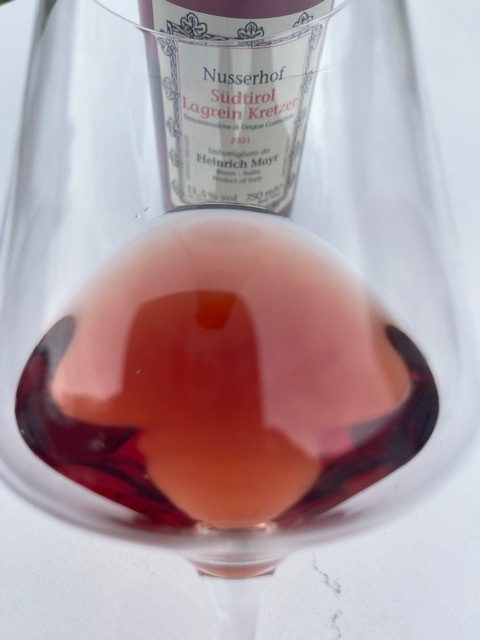Each week, I highlight a wine that leaves a lasting impression—whether for its distinctive character, compelling story, or sheer drinking pleasure. This week’s standout: the 2021 Heinrich Mayr Südtirol Kretzer.
My discovery of this wine was serendipitous. During a recent webinar with Cantina Bozen, a question arose about rosé from Südtirol, the alpine wine region of northern Italy. The answer intrigued me: their version of rosé, known as Kretzer, is distinct from other rosati. The term was new to me, and I love uncovering lesser-known wines. Naturally, I set out to find a bottle—and what I discovered was more than just a wine; it was a glimpse into a region where German and Italian influences intertwine, shaping both culture and winemaking.
Now, let’s dive into the story behind the Alto Adige region, Kretzer, and why this wine deserves a place in your glass.
Alto Adige: A Land of Dual Heritage
For centuries, Alto Adige (a.k.a “Südtirol” in German) was part of the Austro-Hungarian Empire, with a predominantly German-speaking population. After World War I, the Treaty of Saint-Germain (1919) transferred the region to Italy, sparking efforts to suppress its Germanic identity. Under Mussolini, policies banned the German language, renamed towns, and encouraged Italian settlement. Despite this, the region’s Alpine roots remained strong, shaping its architecture, cuisine, and winemaking traditions, where speck and knödel are as common as pasta and espresso.
World War II deepened the region’s cultural divide. In 1939, a pact between Mussolini and Hitler forced South Tyroleans to choose between Italianization or relocation to German territory. Many left, but after the war, those who remained pushed for autonomy. A 1972 agreement granted Alto Adige significant self-governance, preserving its dual identity. Today, both German and Italian are official languages, and this unique blend of cultures is reflected in the region’s wines, where Germanic precision meets Italian artistry.
What is Kretzer?
Kretzer, Alto Adige’s traditional rosé, is crafted from Lagrein, an indigenous grape variety deeply woven into the region’s history. With centuries-old roots, this vibrant wine reflects the unique heritage and winemaking traditions of Südtirol. The term “Kretzer” originates from the German word Kretze, referring to a woven basket used in winemaking to separate freshly pressed grape must from skins and stems—a method commonly employed until the 17th century. This technique was integral to the production of rosé wines in the area, highlighting the longstanding tradition of crafting such wines in Alto Adige.
2021 Heinrich Mayr Südtirol Kretzer.
From the importer Rock Juice: Organic farming, 40-to-90-year-old vines on iron rich porphyric and gneiss soil, 520m elevation, 50/50 combination of direct-press and saignée juice, aged in large oak botti for at least 12 months; bottled unfined/unfiltered with minimal So2.


Tasting Note: Pale cherry color with enticing red cherry, pomegranate, forest floor and dried thyme aromas with a subtle wild flower floral note. On the palate, it’s medium bodied with vibrant acidity and polished tannins which make the wine more structured. It tastes of ripe red cherries, pomegranate, and strawberries with an appetizing bit of resinous, dried herb bitterness and very satisfying finish. 100% Lagrein. 13.5% abv|SRP – $34. Purchase here.
What makes this rosé stand out? Unlike the delicate, pale-hued Provençal style, this is a bolder, more structured expression—one that drinks more like a light-bodied red. While I love the crisp elegance of classic rosés, this style offers even greater versatility, seamlessly balancing freshness with depth. It’s a wine that can hold its own across a range of dishes, from savory starters to smoked fare and even grilled meats. We paired it with Chimichurri Grilled Chicken, and the match was fantastic!
The 2021 Heinrich Mayr Südtirol Kretzer is more than just a rosé—it’s a reflection of Alto Adige’s rich history, where Alpine precision meets Italian artistry. Crafted from Lagrein, it showcases the depth, structure, and food-pairing versatility that set Kretzer apart from more familiar rosé styles. Whether you’re discovering this style for the first time or already a fan of more robust rosés, this wine is a must-try. Its ability to bridge the gap between refreshment and complexity makes it a perfect companion at the table
If you haven’t explored Kretzer yet, consider this your invitation to experience a rosé that challenges expectations and delivers something truly unique.
One Comment
Comments are closed.